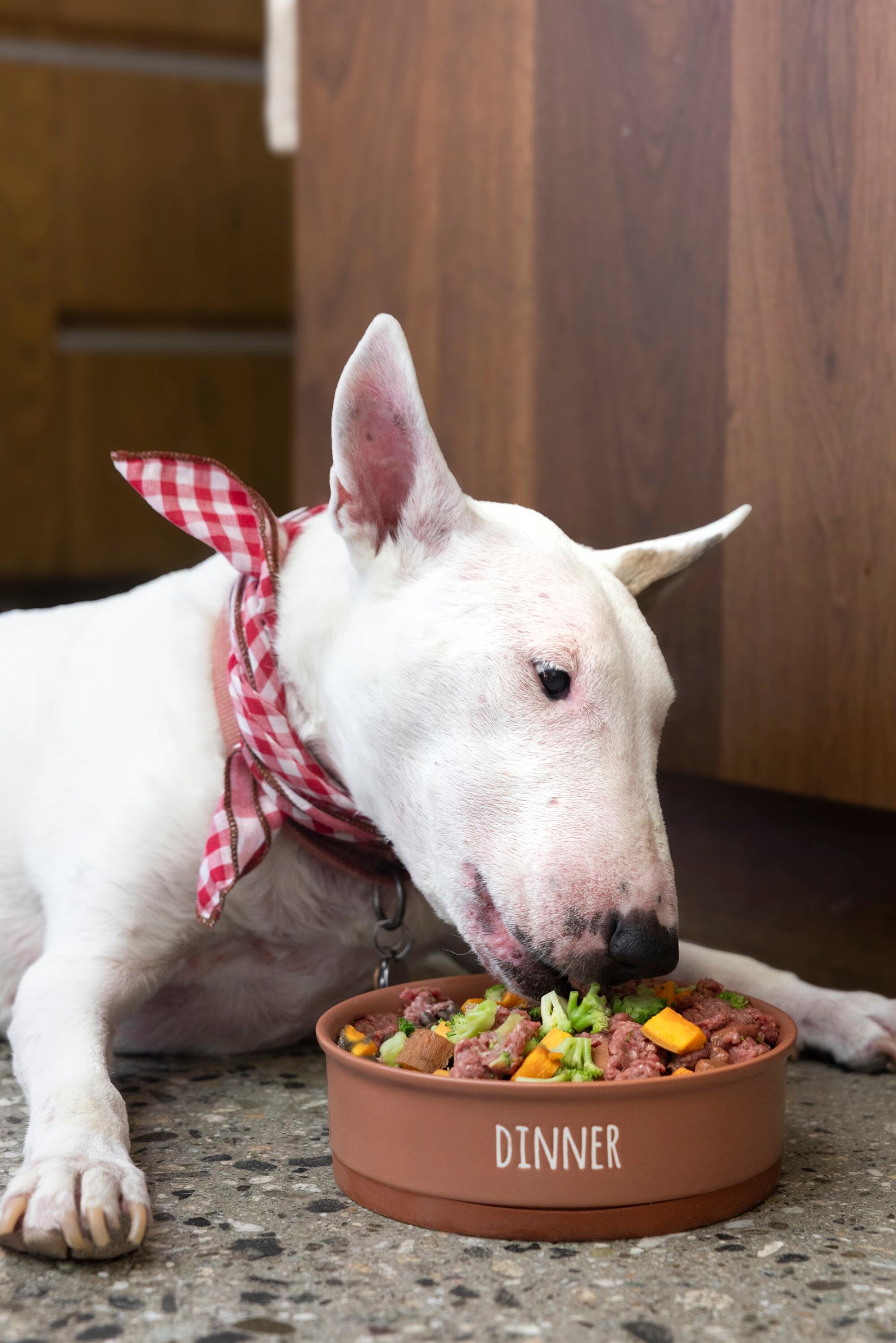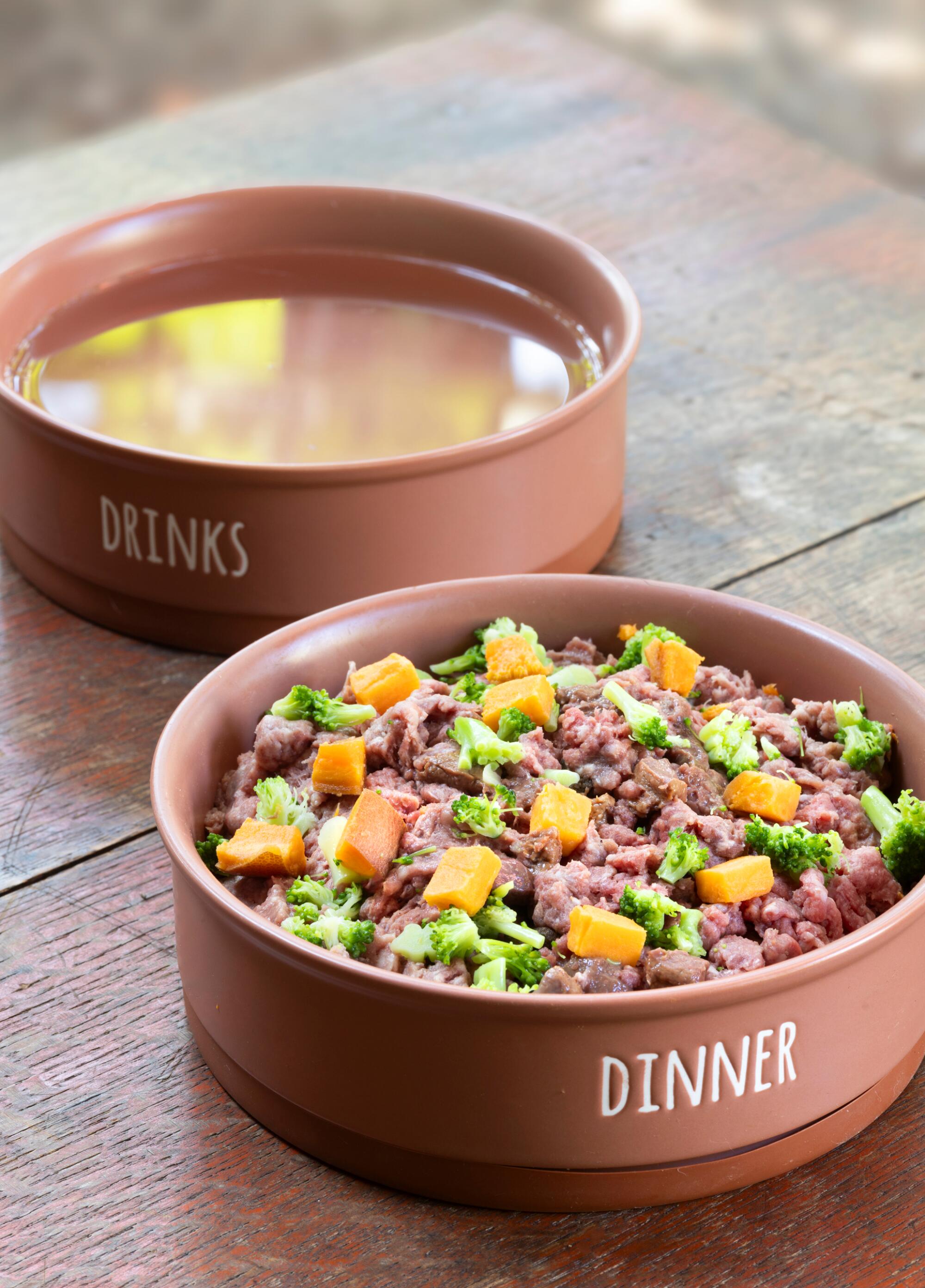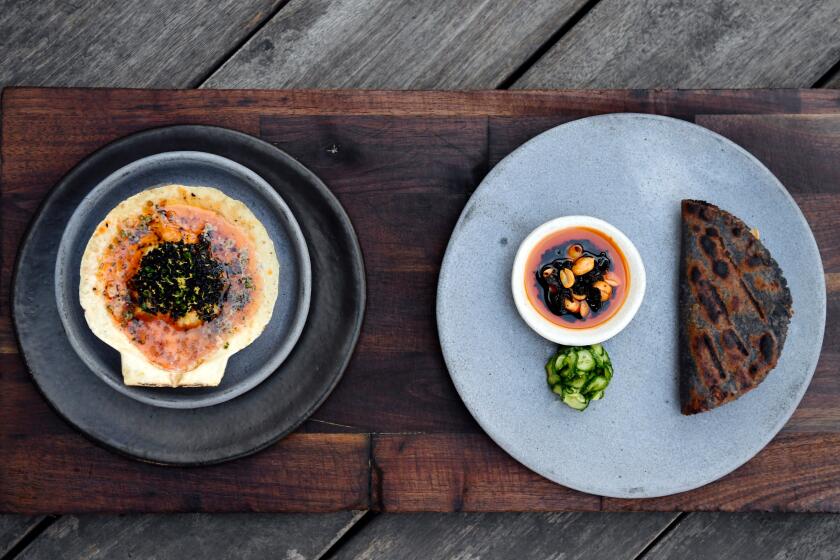
- Share via
My dog Rufus’ wellness journey started with what I now consider an oxymoron: healthy kibble.
Just weeks after I adopted him, Rufus stayed the weekend with his first babysitters, my friend Jamie and her then-partner, a famous country singer. When I came to retrieve my handful-sized little guy, said singer informed me that the so-called healthy dog food I’d proudly left them with (the most expensive one I could find at a grocery store) listed corn and wheat as the first two ingredients. Both were potential allergens for dogs, she said. You have to read the label and make sure meat was the first (and second and third) ingredient on the list.
Los Angeles is a dog town, no bones about it. In this weeklong series, we dig into the obsession.
Or better yet, make his food, like they did.
I had once visited their house and was overwhelmed by the smell of meat — and they’re vegetarians! It turned out to be a boiling cauldron of lamb bones. “For the dogs,” they said.
This was 2008. And it was not uncommon for even the most loving, well-meaning pet owner to feed their dog inexpensive, store-bought dog food. Making your own food for your dog would have been considered exotic. Maybe even a little, errr … overboard, an undertaking reserved for people who said things like, “My dog is my child,” or, as my then-neighbor said before she gave birth to two humans, “I feel like I gave birth to Jackson.” Jackson was, of course, her dog.

Today, human-grade dog food (food that contains ingredients suitable for humans and is processed to the same standards as human food) makes up 30% of the $44-billion-a-year pet food market in the U.S. But back in the aughts, none of the big brands offering this quality of food — Ollie, JustFoodForDogs nor the Farmer’s Dog — even existed. By and large, dogs ate kibble. And by and large, that kibble was made of grains.
Writer Michelle Huneven shares her recipe for cooked dog food hash.
During the same couple of decades the wellness industry — as in human wellness — exploded, to almost $2 trillion nationally. A number too large to contemplate, but suffice to say that 82% of consumers consider wellness a top priority. According to a survey conducted by Pew Research Center, 97% of dog owners consider their dogs part of the family, and 57% of women (43% of men) say their dogs are just as much a member as the human members. That these same humans are projecting their wellness priorities onto their furry family should come as no surprise.
‘I’m gonna love you forever’
When I got Rufus, I was not really a Dog Person. (Which begs the question: Why did you get Rufus? Another story for another time!) But a few days in, I was madly in love with him. He was, as they say in Mexico, my perr-hijo, or “dogchild,” and in no time, the idea of Rufus’ inevitable death was the thing that terrified me most in life. Of course, there are humans whose deaths I can’t bear to imagine, but the difference between a human loved one’s impending demise and that of our canine companions is, in a word: denial.
Humans have long enough lifespans, coupled with anti-aging illusions (Botox and hair dye!) that allow us to put off thoughts of the inescapable — until we can’t. But with the average life of a dog between 10 and 13 years — a span that by the time you’ve reached middle age feels like a season — you could start worrying about the end as early as the beginning. I know I did.

Dog food companies play into that fear in their advertising. The Farmer’s Dog commercial titled “Forever,” which launched during the Super Bowl in 2023, chronicles the life of a chocolate Labrador puppy and a little girl that ends with the girl as a woman and a mother, staring into the soulful eyes of her now white-muzzled dog while the R&B song “Forever” (“I’m gonna looooove … youuuu … forever …”) plays and the words “Nothing matters more than more years together” flash on the screen. (If you don’t tear up watching that ad, I’m guessing you’ve never loved a dog.)
Another Farmer’s Dog ad features a voice-over that says: “The average dog only lives to be 10. At the Farmer’s Dog, we don’t think that’s long enough.” The ad goes on to say, in essence, feed your dog our healthy, pre-portioned food and he’ll live longer.
Rufus came into the world 15 years before this manipulative marketing campaign. And besides, I didn’t need an advertisement to remind me that my days with Rufus were numbered. Simple math told me that it was highly likely that one day, I would be alive in a world with no Rufus in it, and this thought struck me with a cold terror.
What Rufus ate
In the meantime, I felt it was my responsibility that Rufus lived as long as caninely possible, and to make sure that Rufus’ every day on Earth was as good as I could make it. ( I’m thankful he was the kind of kid who could entertain himself with an empty plastic water bottle.) I wanted Rufus to feel good, to have maximum energy, minimal brain fog (ha ha, I know), chase as many sticks and squeak as many toys as possible, feel as loved as a being could feel, and enjoy the yummiest, healthiest food a dog could eat.

After learning about the pitfalls of grains and the limitations of kibble, which is often cooked at such a high temperature as to be stripped of all nutrients, I started making Rufus’ food myself. I am a regular shopper at Huntington Meats, and one day when I was buying marrow bones for Rufus, Jim Cascone, the owner, told me about an off-menu item: pet food! (Today there is a banner promoting their pet food.) He brought a bag of Rubik’s cube-size blocks of frozen meat, a blend of liver, kidney, spleen and hearts. From then on, as long as we were in Los Angeles, that — along with some custom additions — is what Rufus ate.
At first, I mixed the meat with a freeze-dried vegetable mix for dogs. Like astronaut or camping food, it came in a pouch — and it didn’t smell or look like any vegetable I’d want to eat! So I looked at the ingredients, and since sweet potatoes were first, I added those, steamed or baked, to the meat. I also added fresh broccoli because it’s my favorite vegetable, and it so happened to be one of Rufus’ favorite foods too. And I added ground beef to the mix, because it seemed luxurious; and bone meal after a veterinarian told me, “Even though dogs have been domesticated, their G.I. tracts haven’t changed.” They need to eat bones.
I made a big batch of this mixture and froze it in pint-size containers labeled Rufus Hash. Rufus loved it, and perhaps just as important: Every time I fed him I felt like I was giving him the best shot at a great and long life.
Despite my best efforts, Rufus died. He left this world after 14 years and five months on a glorious March day during peak jacaranda season, in 2021 in Mexico City, where we were living and loving life at the time.
And that’s the thing. No matter what we do, regardless of what we feed them or the integrative medicine (including, in Rufus’ case, reiki, homeopathy, electromagnetic therapy and acupuncture), despite the walks and the talks and the love that we give, they leave us. But first, they love us. And they live with us happy and healthy, and along the way, we show them that they are as important to us, oftentimes more important, than any two-leggeds in our midst. We treat them like the precious beings and the members of the family that they are. And that, tragically, is the most we can do.
Adiós, my little Rufino. May there be pigs’ ears and calves’ liver wherever you are. And may Rufus Hash be your legacy.
Get the Recipe
'Rufus Hash' Raw Dog Food Blend

More to Read
Eat your way across L.A.
Get our weekly Tasting Notes newsletter for reviews, news and more.
You may occasionally receive promotional content from the Los Angeles Times.













